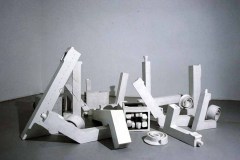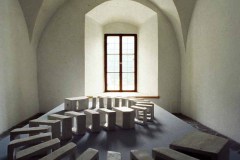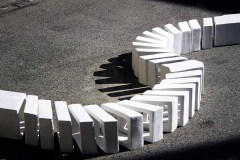
city of sound
The fictional city was developed from rectangular old wooden organ pipes and alabaster objects, plastered and installed as a spatial score.
KV Ebersberg/ Hirschbichl Castle,
KV Werfen/Tennek,
Gallery Karin Sachs, Munich,
Witzel Gallery, Wiesbaden, 1995
city of tones by Dr. Hanne Weskott:
“To make a piece of music is to create silence,” said John Cage. Only in silence can we perceive the otherwise unheard sounds of the empty space, its sound image. But the basic condition of our ability to perceive is structure. Thus Cage stated in his “Lecture on Nothing” in 1959: “What we need is de silence, but, what the silence wants is for me to keep talking”. The artist provides the necessary structure, so to speak, to make perception possible; he makes the offer. The “city of sound” is another such offer. No sound is produced in it, and yet it harbors a variety of possible tones in addition to its real sound image.
Nele Ströbel herself was inspired by the whispering and rustling of the wind around Manhattan’s skyscrapers when she set about building her “stadt der töne” (city of sounds), which looks like an exciting arrangement of simple stereometric basic shapes. Only a few openings and bulges that suggest an unusual functionality in the field of abstract sculpture have an alienating effect in this viewing plane. In fact, a large part of the elements are found objects: Parts of a disassembled organ. So they derive quite concretely from a tool = organon for music production, but not to a music production in the sense of john Cage. But the tool is deprived of its function, although not entirely: a single tone production is possible as long as the resonator and air valve are intact.
In the “city of sound,” however, this is of secondary importance. Not for nothing all parts are whitened, sanded and wrapped with membrane paper: smooth, perfect, not inaccessible, but averse to curious fingers.
This city is manageable and hierarchically ordered like its role models and its predecessor, the organ, and yet, compared to the latter, there is downright chaos. The strict formation of the stops that allow this instrument to sound like an orchestra, a city of sounds of a very different kind, is destroyed. But from this pile of wood, which is such a disassembled organ, something new has emerged, with its own laws, its own rhythm of movement and its own sounds. But Nele Ströbel not only built her city from organ parts, she also designed rotational molds made of A labastergips to emphasize the formal aspect: the soft curvature against the strictly hierarchical principle of the organ pipes and the broad, open rectangular boxes.
We can perceive the “city of sounds” as a pure play of forms , as an image of the city as we see it from church towers or skyscrapers. But then we are missing the part of the tones that we do not want to refer only anecdotally to the organ that used to exist: the real tones in the room. These are also imaginable through the different materials of the sounding bodies: the hollow pipes, the plaster rotations and the wooden boxes with their interior condensations. Theoretically, one could create music here with three different sound bodies, but this would contradict the artist’s intention. She did not build an instrument, but designed a picture of a city and dedicated it to sounds, although the sounds of a city, and especially a city with skyscrapers, (is) the “main source of all the physical and psychological degenerations from which we suffer. “2
A city of sounds versus a city of noises or noise: a silent city whose soundscape we can only perceive if we abandon ourselves to silence, not wanting anything, not categorizing and attributing anything: Silence please!
Hanne Weskott
Catalog of the exhibition “John Cage and the Modeme” Munich 1991, p.23
21 Catalog of the distribution “From Prof itopolis to the City of People”. Munich 1979 p.7
|
|
|
|



















